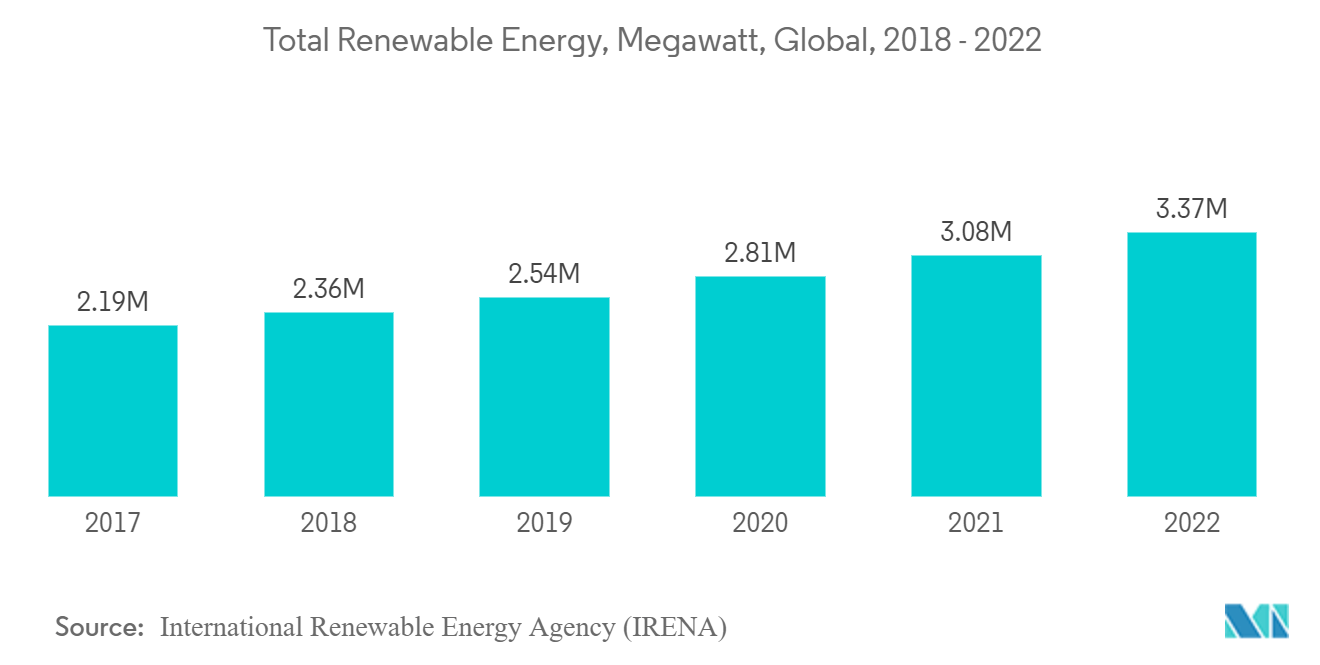Market Trends of Carbon Nanotubes Industry
Energy Segment to Dominate the Market
- Carbon nanotubes (CNTs) received much attention as catalyst support for energy applications, primarily solar cells, fuel cell catalysts, and hydrogen storage, due to their high surface area and conductivity. These unique properties allow CNTs to be used as supplemental material for energy conversion and storage devices.
- Renewable growth is propelled by more ambitious expansion policies in critical markets, partly in response to the current energy crisis. The accelerated adoption of renewable energy in the last five years’ expansion rate results primarily from two factors.
- First, high fossil fuel and electricity prices resulting from the global energy crisis made renewable power technologies much more economically attractive,
- Second, Russia’s invasion of Ukraine increasingly caused fossil fuel importers, especially in Europe, to value renewable energy's energy security benefits.
- China plans to install almost half of new global renewable power capacity over 2022-2027, as growth accelerates in the next five years despite the phaseout of wind and solar PV subsidies. Ambitious renewable energy targets in the 14th Five-Year Plan, market reforms, and provincial solid government support provide long-term revenue certainty for renewables.
- The European Union, the second-largest growth market after China, had stable renewable capacity expansion in the past five years compared to 2010-2015. But its pace of development is expected to more than double during 2022-2027. While several EU member countries had already introduced ambitious targets and policies to accelerate renewable energy deployment before Russia invaded Ukraine since then, the European Union proposed even more aggressive goals under the REPowerEU package to eliminate Russian fossil fuel imports by 2027.
- In the United States, renewable energy expansion almost doubled in the last five years. The IRA passed in August 2022 extended tax credits for renewables until 2032, providing unprecedented long-term visibility for wind and solar PV projects. In India, new installations are set to double over our forecast period, led by solar PV and driven by competitive auctions implemented to achieve the government’s ambitious target of 500 GW of renewable power by 2030.
- Therefore, these factors are projected to boost the consumption of carbon nanotubes in the energy industry.

Asia-Pacific to Dominate the Market
- China is the largest producer and consumer of carbon nanomaterials in Asia-Pacific. The abundance of available raw materials and the low cost of production supported the growth of the carbon nanomaterials market in the country.
- Because of CNT’s extraordinary electrical properties, CNT finds applications in electrical and electronic applications such as photovoltaics, sensors, semiconductor devices, displays, conductors, fuel cells, harvesters, and batteries.
- China includes the world’s most extensive electronics production base and offers tough competition to existing upstream producers, such as South Korea, Singapore, and Taiwan. Electronic products, such as smartphones, OLED TVs, tablets, etc., include the highest growth in the market in the consumer electronics segment. With the increase in the disposable income of the middle-class population, the demand for electronic products is estimated to grow, thereby driving the CNT market shortly.
- The Indian government is talking with significant semiconductor companies to set up local manufacturing. The government invited new applications for setting up Semiconductor Fabs and Display Fabs in India from June 2023 under the Modified Semicon India Programme with an outlay of INR 76,000 crore (~10 billion USD).
- The country saw large investments in the automotive sector. Recent and planned investments and developments in the automobile sector include
- In January 2023, MG Motor India announced a USD 100 million investment to expand capacity. In December 2022, Mahindra & Mahindra revealed plans to invest INR 10,000 crore (USD 1.2 billion) in an EV manufacturing plant in Pune. This investment emphasizes the growing significance of the EV sector.
- Japan’s electronic products industry is the most significant factor driving demand for semiconductor sales in Japan. Japan includes about 30 semiconductor fab industries that are involved in the manufacturing of various semiconductor chips. Japan’s semiconductor production registered a 13% y-o-y in 2021 and 10% in 2022, with production value reaching JPY 3,074.6 billion (USD 23.31 billion). The growth for the year 2023 is forecasted at 1%.
- As per the reports by the Japan Automobile Manufacturers Association (JAMA), the country produced 7,427,179 units of passenger cars and 1,286,414 units of trucks in 2022. It is likely to impact the CNT market.
- Hence, due to the reasons mentioned above, Asia-Pacific is anticipated to drive the market's growth during the forecast period.


